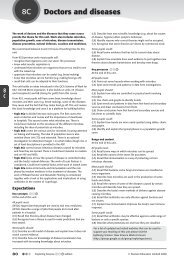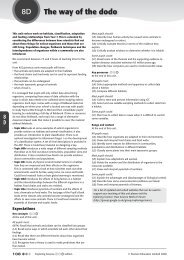8E TEACHER GUIDE.pdf - swallowhillresources
8E TEACHER GUIDE.pdf - swallowhillresources
8E TEACHER GUIDE.pdf - swallowhillresources
- No tags were found...
Create successful ePaper yourself
Turn your PDF publications into a flip-book with our unique Google optimized e-Paper software.
<strong>8E</strong>In the drink<strong>8E</strong><strong>8E</strong> Background Information<strong>8E</strong>a – Using water/The solution is clearDissolving is a topic that is superficially very simple, but canactually lead to some very complex ideas. One of the key ideasto be brought out is that true dissolving will only occur when thesolute is broken down into particles that are too small to be seenwith the naked eye. A common error will be to assume that anyform of dispersion is evidence of dissolving – the fact that ‘soluble’aspirins are often in fact only partially soluble may be a source ofthis misunderstanding. These mixtures are suspensions (though thisword is not used in the Pupil’s Book).Suspended substances may fall to the bottom of the liquid onstanding, or they may, if the particles are small enough, remainsuspended virtually indefinitely. In this case you get a colloidalsuspension, such as an emulsion, gel or aerosol. This is dealt withon Worksheet <strong>8E</strong>a(7).Another common error is the confusion between the meanings ofthe words ‘clear’ and ‘colourless’. The use of ‘clear’ as a descriptionof colourless glass bottles at the bottle bank will not help. In thePupil’s Book the word clear is used to mean transparent, withthe colour of the liquid being an independent description. A fulldescription of the liquid will therefore involve a minimum of twowords (e.g. clear blue, misty yellow, clear and colourless). It mayalso be worth stressing to some pupils the difference between‘colourless’ and ‘white’, perhaps by showing them a test tube full ofwater and one containing milk.Some common models based on solute particles filling up ‘gaps’ inthe liquid have come under critical scrutiny in recent years. At best,they are a gross oversimplification of the actual particle interactions.Particles in a liquid are closely packed, hence the difficulty incompressing a liquid into a smaller volume. These models usuallyoverstate the size of any gaps and/or distort the relative sizes ofsolvent and solute particles (sugar molecules, for example, aresignificantly larger than water molecules).Mixtures are collections of items or substances that have beenbrought together by some physical means and that can beseparated so that each of the constituent parts is obtained. Thisprocess of separation will form the thread through the remainderof this unit, but in every case the method required to separate amixture is a physical one – no chemical reactions are involved andno new chemicals are formed.Filtering is a way of sorting items by size – sieving is an examplethat pupils should be familiar with from KS2 work. Filter papersact in a similar fashion, allowing only tiny particles through andtrapping the rest.Filtering will only separate insoluble solids (which do not dissolve)from the liquid or solvent in which they are found, as dissolvedparticles are small enough to pass through the paper. In a watertreatment plant, filtration can only be used to separate the ‘lumps’from dirty water – floating branches, paper waste, solid humanwaste and particles of soil or dirt. Filtration will not remove thebacteria that live in the water (as they are too small) and it will notremove minerals that are dissolved in it.<strong>8E</strong>b – SolubilityTechnically, solubility refers to the amount of solute that willdissolve in a particular mass or volume of solvent. In this topic, theonly solvent used is water, and the overwhelming majority of dataavailable will relate to aqueous solutions. There are potentially alarge number of possible combinations of mass and volume unitsin which solubility can be expressed, and the resulting values willbe concentrations, typically expressed in grams of solute per 100 gwater, or as moles of solute per cubic decimetre (i.e. one litre) ofsolution. This latter treatment is clearly well beyond the scope ofa KS3 course. Note also the subtle difference between specifyingthe volume or mass of solvent and the volume or mass of the finalsolution.<strong>8E</strong>c – Salt of the EarthEvaporation is a way of extracting dissolved solids from a liquid.If a sample of pure water is evaporated, no solid residue will beleft behind, but if a solution (water containing a dissolved solid, ormixture of solids) is heated the water will evaporate leaving thesolids behind.Evaporation of solutions in the laboratory needs care. The solutionshould be heated until a little remains so that the solid can beformed as the heat stored in the watch glass or evaporating basinevaporates this remaining amount. This will help to stop the solidresidue from ‘spitting’ at the pupils and also limit the number ofbreakages. This process is known as ‘heating to dryness’. If the solidis heated beyond this point, it may ‘jump’ out of the container andmay also be changed by the heat.Copper sulphate is ideal for demonstrating evaporation as its bluecolour means that it can be easily seen. Also, the effect of heatingit too strongly is a very clear change in colour – anhydrous coppersulphate is produced, which is white if too much water (the waterof crystallisation) is removed. The blue colour returns if a little wateris added to the white crystals.Hard water is water with a high mineral content, mostly highlevels of magnesium or calcium carbonates, bicarbonates and/orsulphates. Some of the salts in hard water precipitate on heatingto form scale which blocks up central heating pipes and furs kettleelements. Soap initially reacts with the hardness salts to form ascum, and no lather is formed until all these salts have reacted.Detergents contain different salts, which form soluble compoundswith the hardness salts, and so do not leave scum.Drinking water standards in the UK are set by UK and EUlegislation. The standards set maximum values for concentrationsof various ions, organic molecules, specified microbes, compoundssuch as pesticides, and radioactivity. Sampling is carried out wherewater leaves the supply points, and also at consumers’ taps.<strong>8E</strong>d – What’s in a solution?Chromatography is a way of separating different chemicals in aliquid. The chemicals must be soluble in the liquid being used. Atschool level, chromatography is typically used to separate colouredcompounds such as dyes in ink or food colouring. At higher levelsthe compounds being separated are not necessarily coloured – thechromatogram can be treated to make the separate chemicals visible.Different soluble chemicals form different-sized particles– the smaller the particle the more easily it can move duringchromatography. As the solvent soaks up the paper, the differentchemicals in the sample move at different speeds, resulting in aspread-out series of ‘spots’. If two samples on the chromatogramcontain the same chemical, that chemical will move up the samedistance from the start point as the chromatogram is made.Most dyes, pigments, paints, and so on, are mixed from a selectionof pure chemicals. Different manufacturers of paints/dyes usedifferent combinations of chemicals to achieve the desired colour.This fact is made use of when chromatography is used in policework: a sample of paint can be compared with standard samplesfrom different manufacturers to determine its origin.<strong>8E</strong>e Still water/Focus on: Supplying water/Running out …Distillation is a process used to separate a liquid from a mixtureof either a liquid and a dissolved solid or several liquids, so that theliquid is not lost.13<strong>8E</strong>xploring Science edition © Pearson Education Limited 2008






